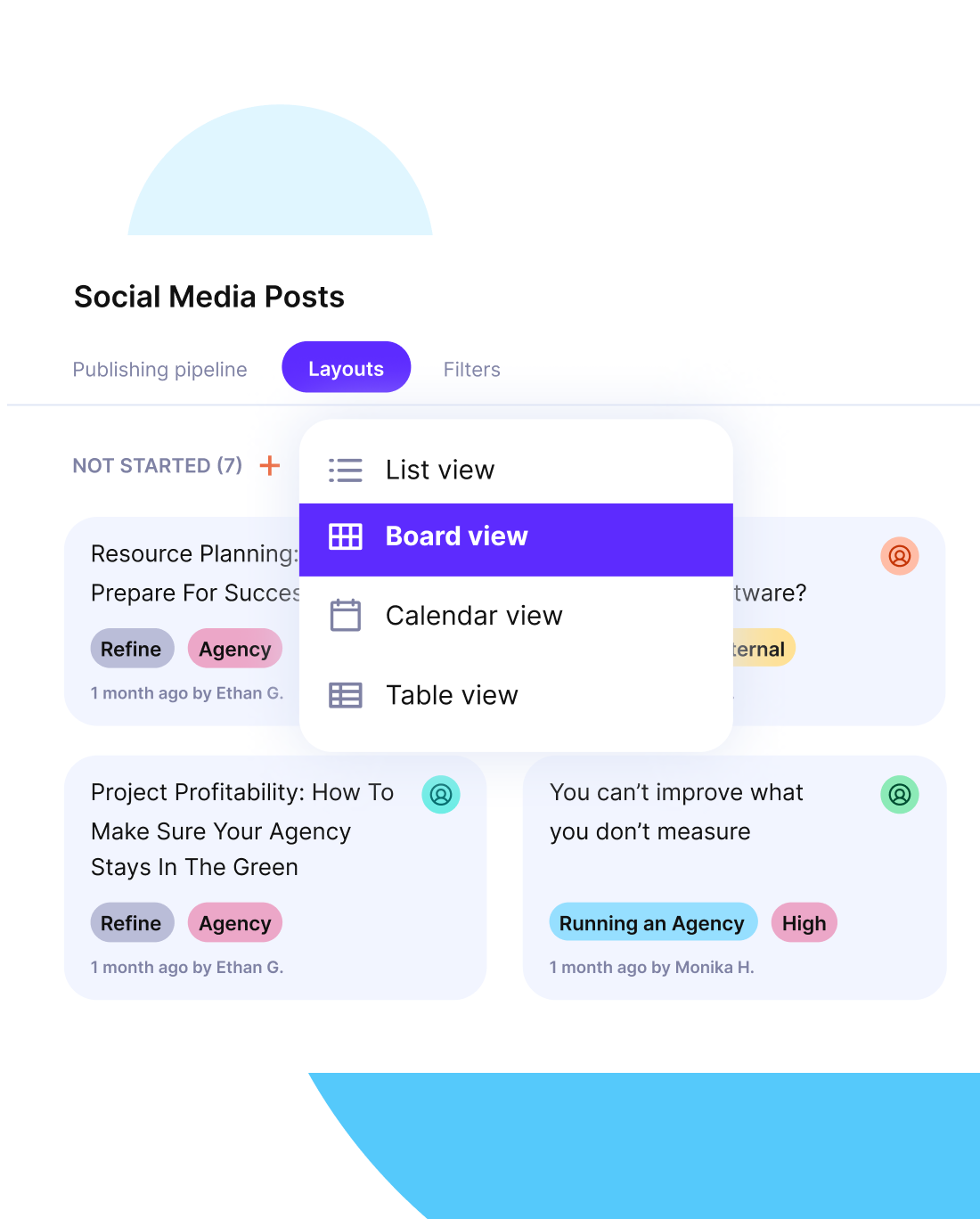Project Implementation: Practical Guide + Free Template
Project implementation often fails because of scope creep, overloaded teams, and unclear approvals. These are usually symptoms of poor planning and weak execution controls.
This guide explains what project implementation means and how it fits into the lifecycle. It’s updated for 2025, so you’ll get practical steps to build and manage a plan, plus a filled example and a free template you can copy.
By the time you’re done reading, you’ll know how to implement projects with clear controls, solve common planning and execution problems, and keep delivery on track.
Key Takeaways
- A project implementation plan translates strategy into daily execution and helps your team members align around shared expectations and responsibilities.
- Projects run smoother when risks, change requests, QA steps, and reporting are built into your working process early rather than added later.
- Project teams that use a structured project management system can control scope easier, plan capacity, and keep visibility high across internal and client-facing workflows.
- You can get started quickly by using the worked example and free project implementation plan template provided in this guide.
What Is Project Implementation?
Project implementation is the stage of the lifecycle where planned work turns into actual delivery. It is distinct from planning, which defines scope and schedules, and from monitoring (which is about progress tracking).
Implementation focuses on mobilizing project teams, resources, and processes to deliver agreed outcomes while maintaining control.
- Purpose: translate strategy and plans into tangible results.
- Lifecycle position: follows planning and precedes monitoring and closure.
- Scope vs execution: scope defines what is to be done, and project execution carries it out under control.
- Controls: ensure risks, approvals, and quality are managed.
- Link to project management: provides structure to coordinate people, tasks, and project reports.
What Is a Project Implementation Plan?
A project implementation plan is a structured document that guides how a project moves from strategy into delivery. It differs from a generic project plan by focusing on aligning project goals, resources, risks, and monitoring into one actionable project roadmap.
The plan matters because it ensures everyone knows what to deliver, how to deliver it, and how progress will be controlled. Here are the main reasons why a project implementation plan is important:
- Aligns project goals and objectives with daily execution.
- Maps resources and responsibilities clearly.
- Lists risks and sets up mitigation steps.
- Defines monitoring and reporting processes.
- Serves as a shared baseline for the team and stakeholders.
What Are the Components of a Project Implementation Plan?
The core components of a project implementation plan include objectives, scope, schedule, resources, risk management, change control, QA, communication, and handover.
These elements are especially important for project-based firms and service teams working on tight timelines and shared resources.
Below is a full project plan component list and what it should include:
- Objectives and goals: This component defines the intended outcomes of the project. For service teams, having clear project objectives ensures alignment with the client’s expectations and allows internal teams to measure project success.
- Scope and deliverables: This outlines what work will be done and what will be delivered. Agencies rely on a defined project scope to avoid scope creep and manage client expectations without surprise additions.
- Work breakdown and milestones: This breaks the project into phases, tasks, and checkpoints. It helps agencies distribute workload and spot timeline conflicts early.
- Schedule and dependencies: This maps the timeline and shows which tasks rely on others. It’s especially helpful when approvals or client inputs could delay dependent work.
- Budget and resources: This links time, people, and money. Agencies use this to align rates and effort with financial targets, avoiding margin erosion.
- Team roles and responsibilities: This assigns owners to tasks and deliverables. Clear accountability prevents duplication and ensures each team member knows their lane.
- Risk register and mitigation: This logs potential problems and what to do about them. It gives delivery teams a proactive way to address blockers before they escalate.
- Change control process: This outlines how scope changes are submitted, reviewed, approved, and reflected in the plan. A documented process protects both agency margins and client trust.
- Quality gates and acceptance criteria: This defines how work is reviewed and approved. QA checkpoints and UAT steps reduce the chance of last-minute surprises or rushed fixes.
- Communication plan and stakeholder approvals: Stakeholders should agree on status cadence and approval workflows. This keeps everyone aligned, prevents surprises, and supports smoother decision-making.
- Performance metrics and reporting cadence: This defines how progress will be measured and shared. A small, visible set of KPIs can help teams and clients catch problems early.
- Assumptions, constraints, dependencies: This makes all project limitations explicit. It gives teams a shared understanding of risks, resource gaps, or fixed conditions.
- Hypercare and handover plan: This defines the support period after delivery. Structured handoffs reduce post-launch surprises and ensure ongoing support is scoped properly.
How Do You Create a Project Implementation Plan (Step-by-Step Process)?
To create a project implementation plan follow a step-by-step process: define your objectives, translate them into deliverables and milestones, allocate resources based on capacity, schedule work with dependencies, plan budgets and risks, formalize quality checks, set up change control, agree on communication, and build in tracking and handover.
The rest of this section walks through the expanded steps that you can follow to build a implementation plan with clear, repeatable actions.
Step 1: Confirm objectives and scope baseline
Clarify what the project aims to achieve and what’s explicitly out of scope. Use the signed proposal or discovery brief as your source. In Productive, you can attach goals directly to project budgets, so you always have the business context when tracking progress.
Step 2: Break down deliverables into tasks and milestones
Convert outcomes into actionable steps with clear milestones. Assign owners to each major phase. This creates a task list with due dates and responsibilities your team can actually work from.
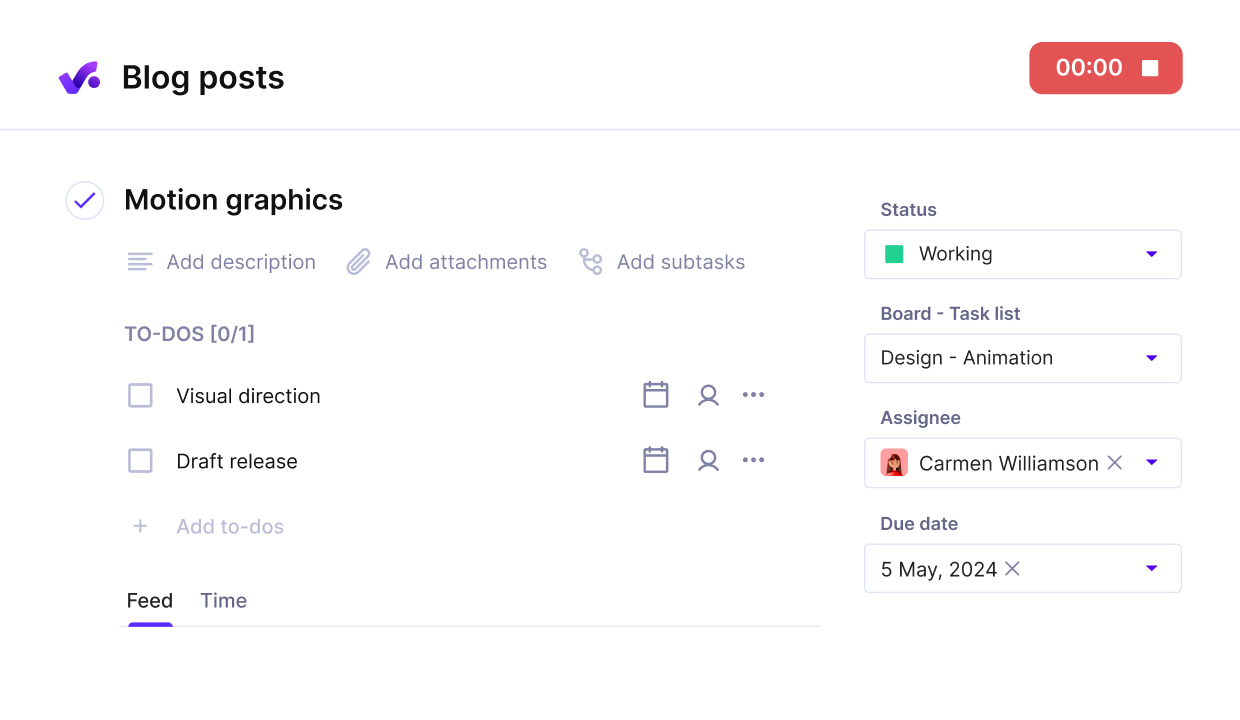
Add task descriptions, checklists, and assign owners directly on tasks.
Step 3: Map roles and resource allocation against capacity
Assign roles based on availability, not assumption. Use a tool that lets you see real-time capacity, so you can resolve overlaps before the project even starts. Productive lets you forecast workload and spot resourcing conflicts early.
Step 4: Build the schedule with dependencies
Lay out the timeline and mark which tasks rely on others. Include buffers for feedback and approvals to avoid last-minute bottlenecks. The result is a schedule that keeps work unblocked and on pace.
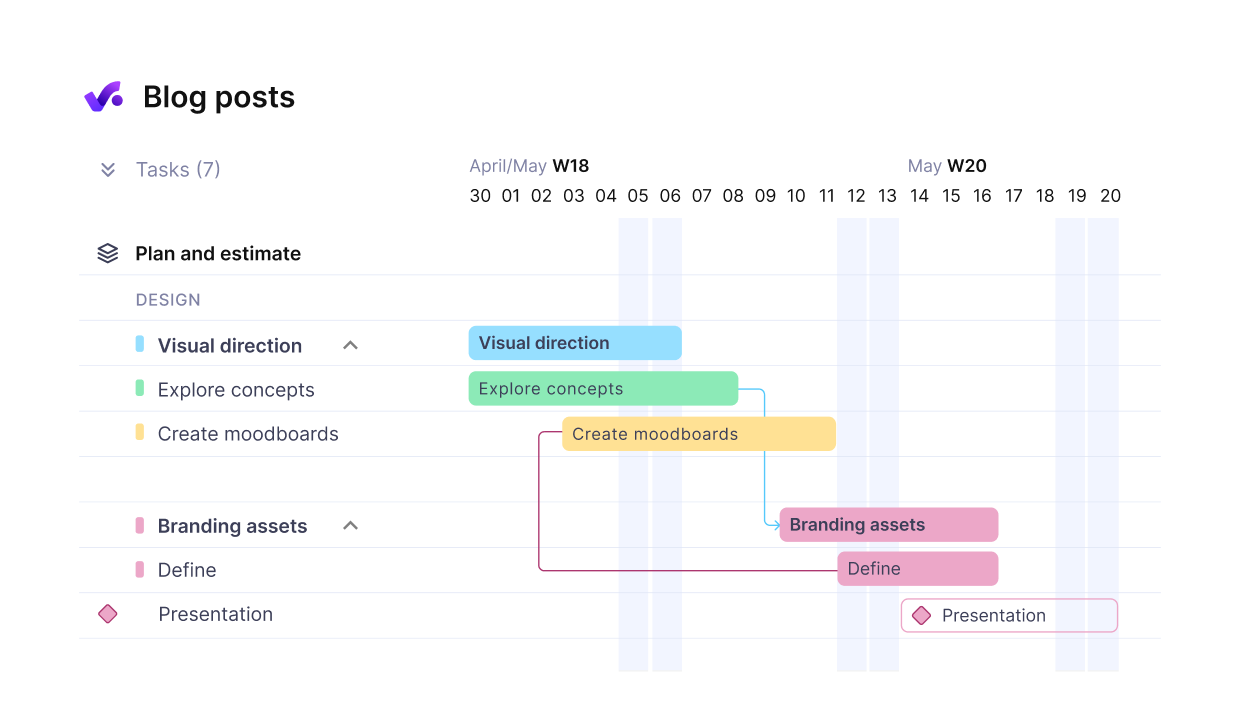
Use Productive’s Gantt charts to map out the implementation process with tasks and dependencies.
Step 5: Baseline the budget
Translate time and resources into a realistic cost structure. Link effort and rates to team roles. For fixed-fee projects, include a buffer. Productive helps you create budgets directly from project plans and track them as work progresses.
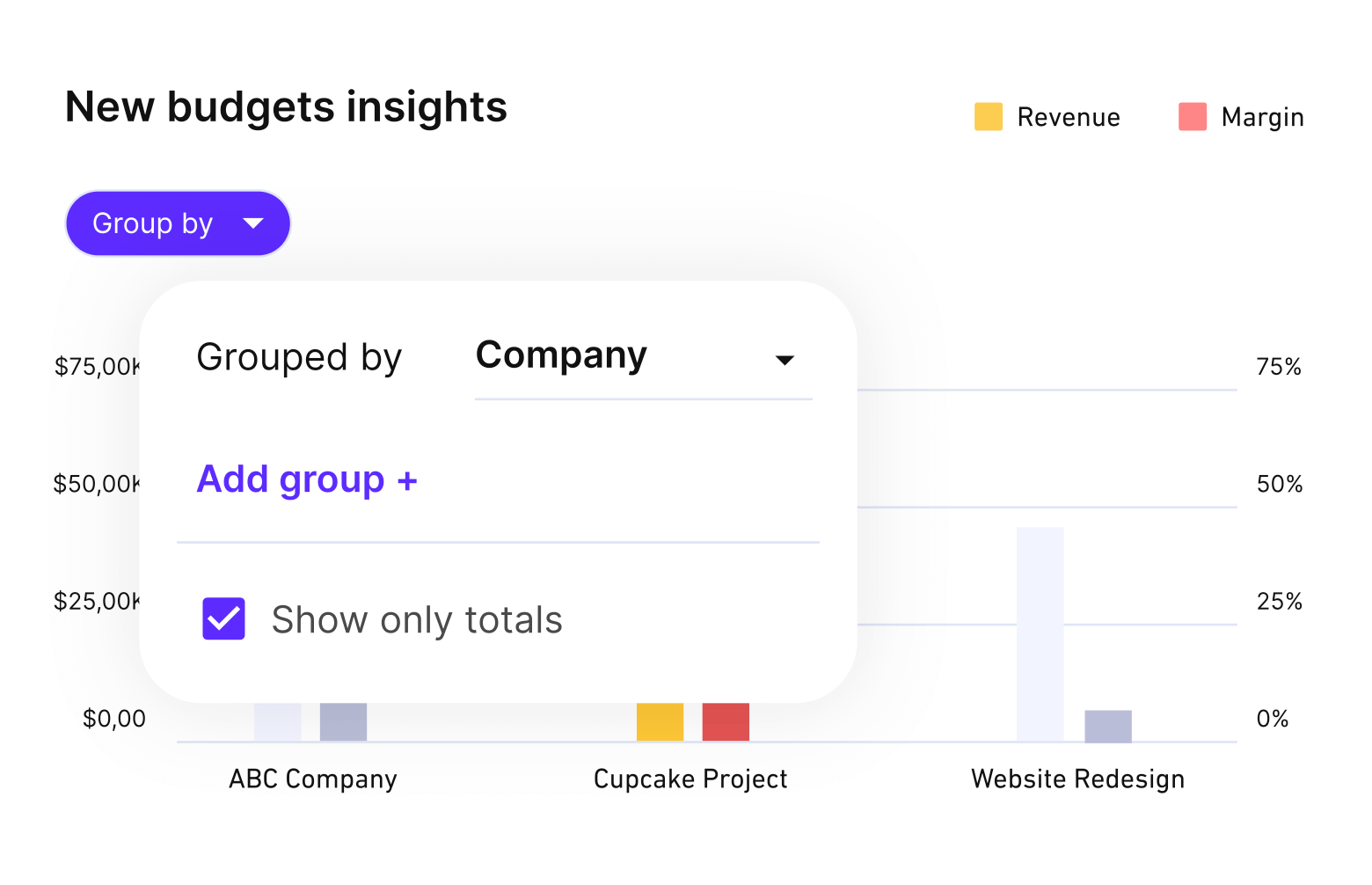
Create and adjust budgets in real-time.
Step 6: Identify risks
List potential blockers and define what might trigger them. Add mitigations and assign owners. Keep the risk register visible and review it weekly so you’re always one step ahead.
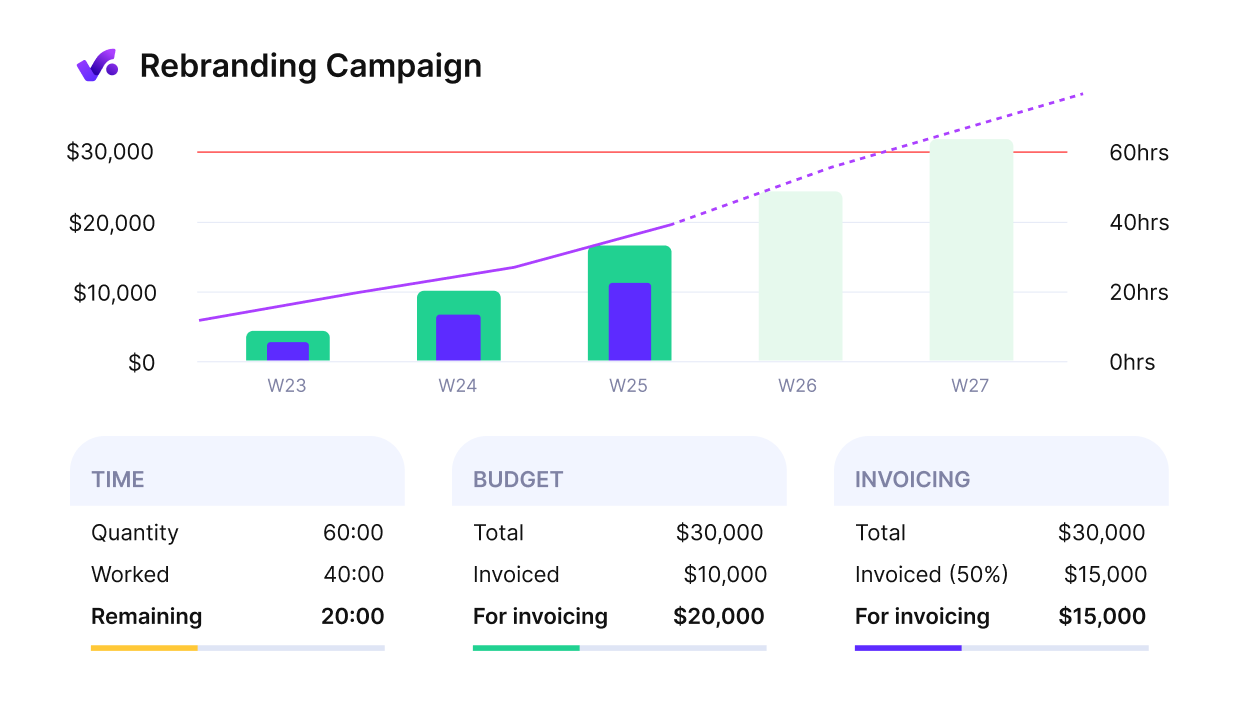
Productive gives you an early warning of budget overruns.
Step 7: Define QA gates and acceptance criteria
Set standards for what counts as “done.” Include internal reviews, UAT steps, and sign-off criteria. Productive makes it easy to track QA tasks directly on project boards.
Step 8: Set up a change management flow
Create a simple, repeatable process for how scope changes are requested, evaluated, and approved. Include fields for effort impact, cost, and timeline adjustments. Every change should be tied back to your plan and baselined before moving forward.
Step 9: Create the communication plan
Define how updates will be shared and who needs to approve what. Stakeholders should agree on status cadence and approval workflows before the project starts to avoid confusion later.
In case you’re having a hard time with this step, head over to our communication plan guide.
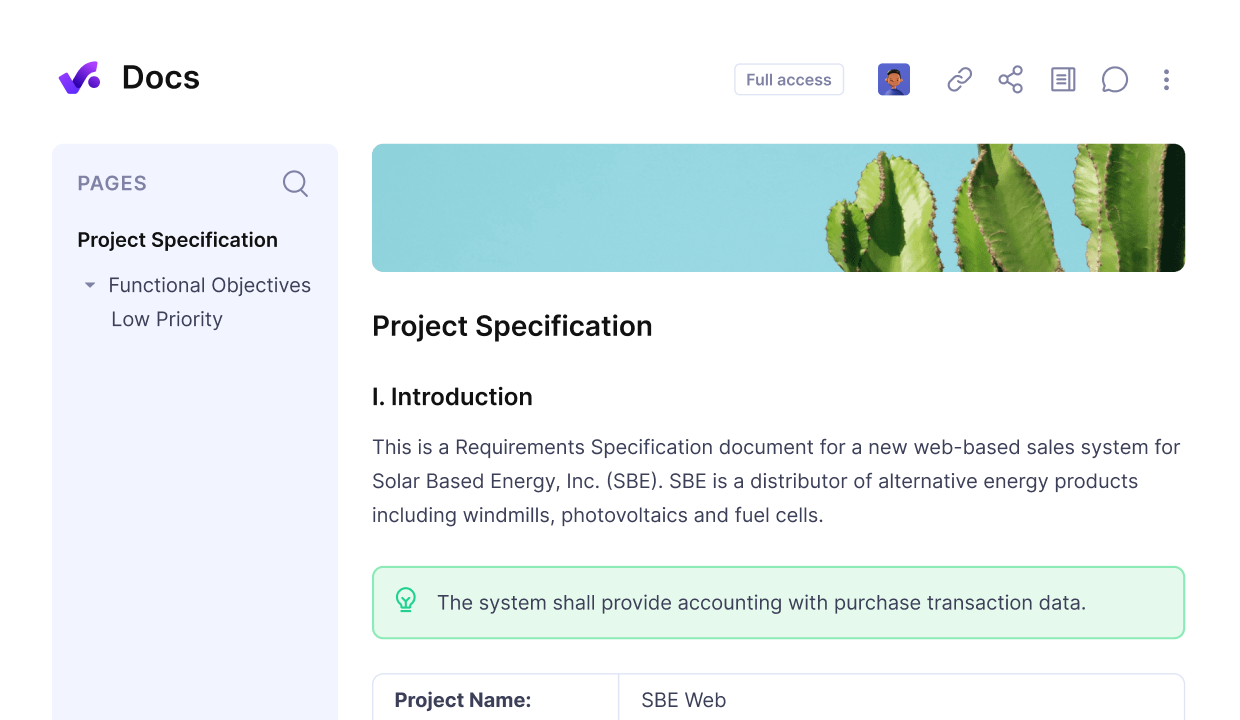
Keep all project documentation in a single place for editing and collaboration.
Step 10: Configure tracking and dashboards
Pick a small set of metrics like burn rate, forecast to complete, and blocker aging. Productive lets you build dashboards that surface both internal KPIs and client-facing status at a glance.
Step 11: Final review and kickoff
Bring all project artifacts into one place, check resource alignment, and run your kickoff. Make sure everyone’s clear on timelines, responsibilities, and what happens during the hypercare period after launch.
Implement projects with Productive
What Is a Good Example of a Project Implementation Plan?
A good example of a project implementation plan would be a website redesign for a mid-market client (a typical client service engagement). It shows how agencies or service teams can align with client stakeholders, manage approvals, and control delivery across phases.
Example scenario: Website redesign for a mid-market client.
- Objectives and goals: Improve lead quality by 20% in 90 days; cut bounce rate to 35%.
- Scope and deliverables: Site map, copywriting, UI/UX design, CMS development, analytics setup, and training materials.
- Roles and team members: PM, UX designer, UI designer, copywriter, developer, QA tester; client sponsor and subject matter expert.
- Schedule and milestones: Discovery (weeks 1–2), Design (weeks 3–5), Build (weeks 6–9), QA/UAT (weeks 10–11), Launch (week 12), Hypercare (30 days post-launch).
- Budget and resources: 600-hour estimate with a blended rate model; 10% contingency buffer.
- Risks: Potential content delays, SME availability issues, and SEO regressions; each has defined mitigations.
- Change control: Formal CR form includes fields for scope, cost/time impact, and decision log with updated baseline.
- QA and acceptance: Checklist covers copy accuracy, layout consistency, mobile responsiveness, page speed, and analytics tracking.
- Communication plan: Weekly status updates, biweekly demo reviews, and approval gates after design and UA
- Metrics: Burn rate, forecast to complete, blocker aging, and variance to plan are tracked regularly.
What Can You Learn From This Example?
This example works well because it connects each component of the plan to a concrete output or control mechanism. It’s realistic, detailed, and tailored to the way service teams operate:
- Every phase is time-boxed and mapped to milestones, which prevents scope drift.
- Responsibilities are clearly split between internal and client-side roles, reducing miscommunication.
- Risk, change, QA, and communication are built into the plan, not added as afterthoughts.
- Metrics are minimal but actionable, helping track burn and forecast without overhead.
If you’re using a platform like Productive, it becomes easier to keep each part of the plan connected to the actual work. Instead of juggling spreadsheets and side docs, the full plan is in the same place where your team already works.
- Objectives, budgets, and time estimates stay visible on each project.
- Tasks, schedules, and dependencies are mapped through the planning view.
- Change requests, risk logs, and QA steps can be tracked as tasks or custom fields.
- Dashboards bring visibility to blockers, burn rate, and forecast at a glance.
Where Can You Get a Free Project Implementation Plan Template?
You can use the free project implementation plan template below to get started. To keep it useful, set it up inside your project management tool so the plan stays current as work progresses.
Template:
- Project name:
- Objectives and goals:
- Scope and deliverables:
- Milestones and schedule:
- Roles and responsibilities:
- Budget and resources:
- Risk register: [risk, owner, trigger, mitigation]
- Change control: [request, impact on cost/time/scope, decision, baseline update]
- QA and acceptance criteria:
- Communication plan: [cadence, channels, approvers]
- Performance indicator metrics: [burn rate, forecast to complete, blocker aging, variance]
- Hypercare and handover plan:
If you’re managing implementation in Productive, you won’t need to keep this template in a separate document. Each part of your plan can be tracked directly on the project itself, from objectives and tasks to change requests, QA steps, and performance metrics.
You can connect budgets to project deliverables, forecast team capacity, and stay aligned with clients through live dashboards.
That’s the real value. Instead of writing the plan once and watching it go stale, Productive helps you keep it active, visible, and connected to the work your team is already doing.
What Are Common Project Implementation Challenges (+ How To Avoid Them)?
The common project implementation challenges are scope creep, resource conflicts, missed QA or acceptance gates, and poor communication are common. The good news is that each one can be solved with the right processes in place.
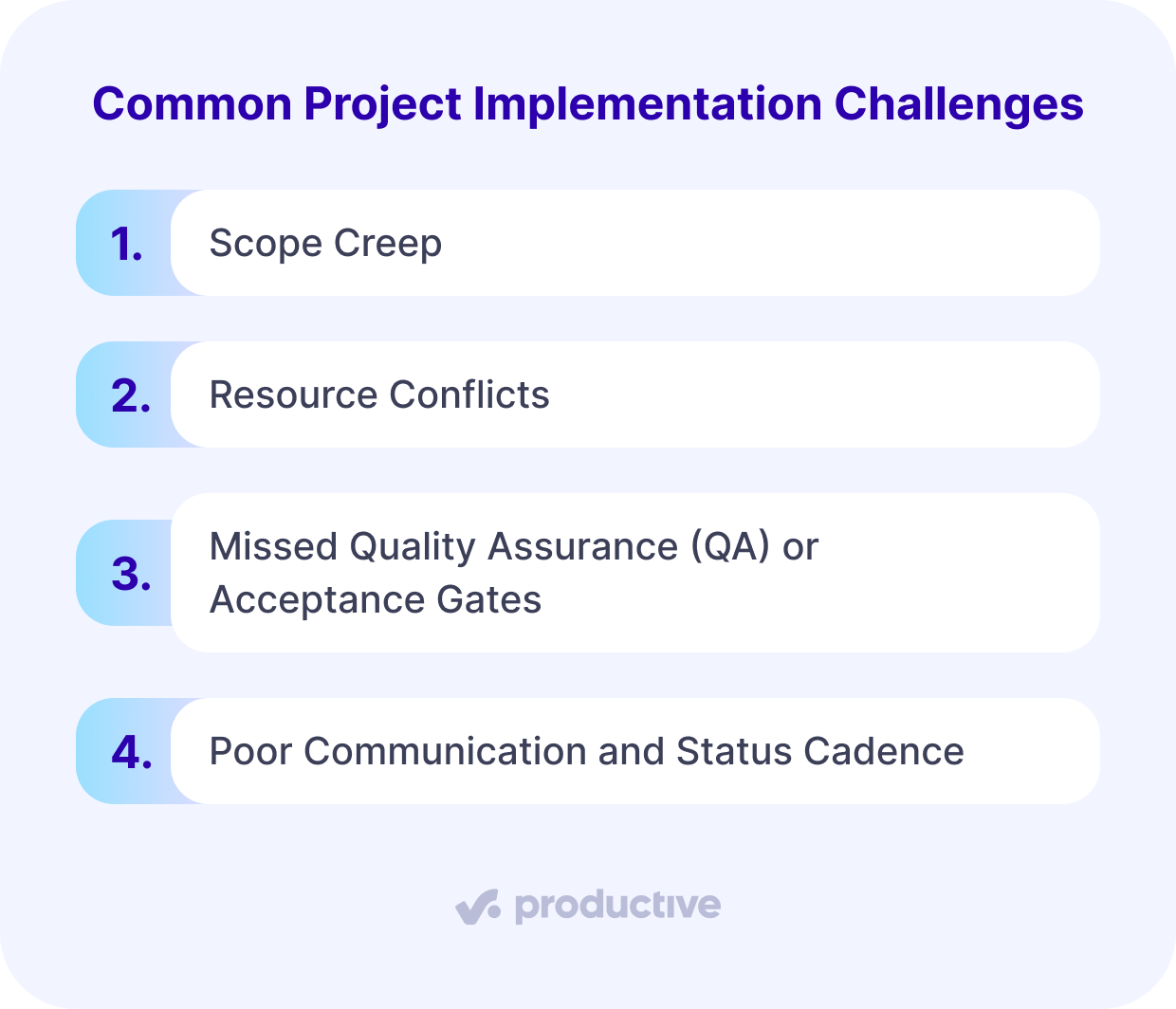
Below is a breakdown of the most common challenges teams face, along with specific ways to address each one before they derail delivery.
Challenge 1: Scope Creep
Client adds features midstream, often through informal requests or quick asks. This puts pressure on timelines and causes silent scope expansion.
How to avoid: Set up a change request workflow that includes effort estimation and stakeholder sign-off. Each approval should come with a clear view of the timeline impact, additional hours or costs, and how it affects the original scope. Make the workflow visible to both internal teams and the client.
Challenge 2: Resource Conflicts
Key team members are overbooked across multiple projects, leading to delays or rushed handoffs.
How to avoid: Track capacity at least weekly. Build a review rhythm where project managers scan upcoming allocations, spot overloads, and resolve conflicts before they hit delivery. Use your project management tool to view cross-project resourcing in real time.
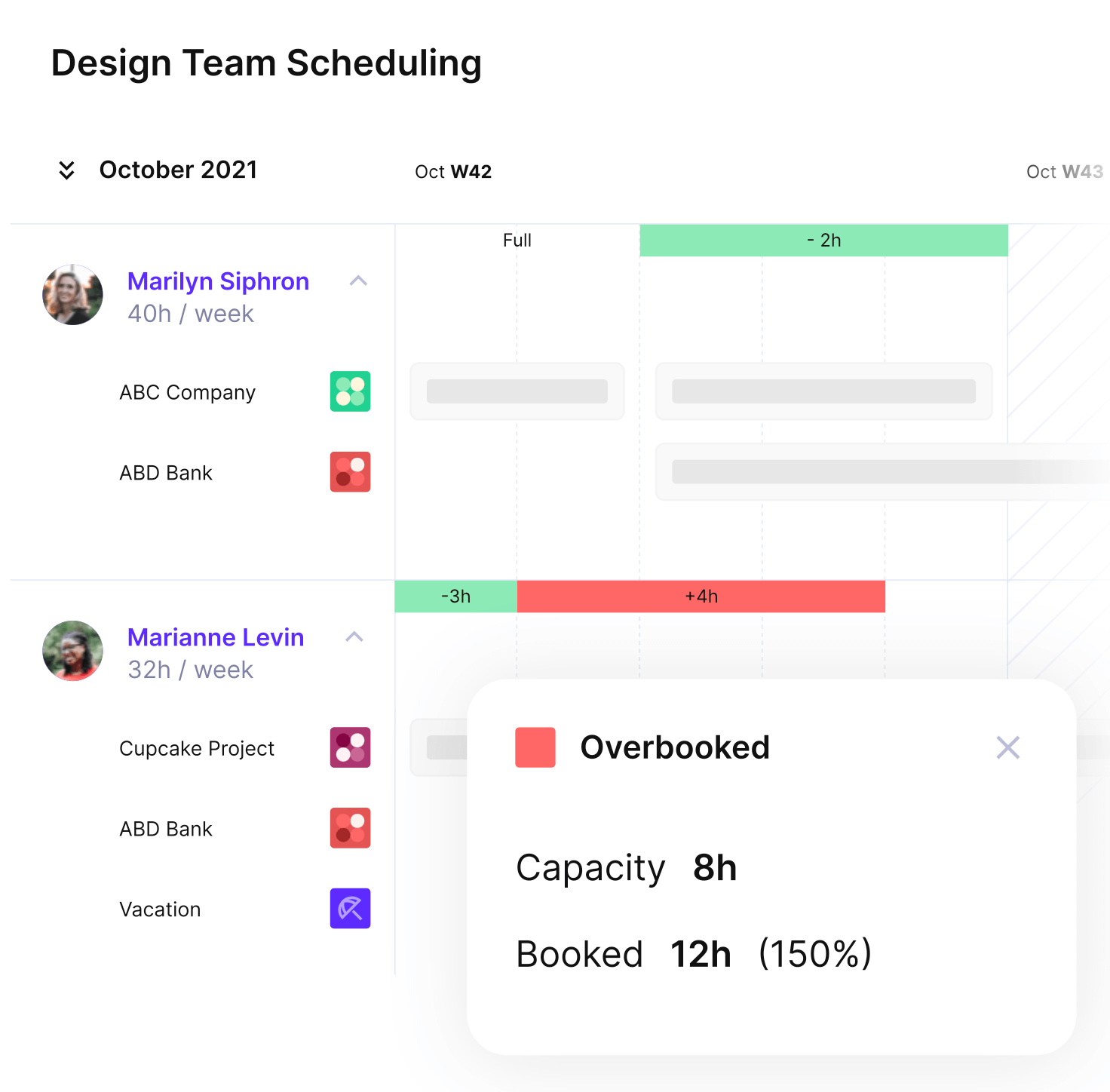
Productive gives you a real-time overview of your team members availability.
Challenge 3: Missed Quality Assurance (QA) or Acceptance Gates
The team rushes toward launch without a full review, and defects slip into production.
How to avoid: Define acceptance criteria up front. Make sure every phase ends with a QA checklist, sign-off step, or review gate. Don’t schedule go-live until acceptance is explicitly approved by both internal and client-side reviewers.
Challenge 4: Poor Communication and Status Cadence
Clients are surprised by blockers or misaligned on timelines. Feedback gets delayed or unclear.
How to avoid: Set a fixed status cadence with weekly updates and stakeholder touchpoints. Use a consistent format for updates, covering blockers, budget, and upcoming milestones. Escalation paths should be clear to everyone involved.
How Do You Manage Risks, Changes, and Progress During Implementation?
You control implementation by setting up lightweight loops for risk management, change tracking, and regular status updates. These loops act as early-warning systems and keep everyone focused on the current state of delivery.

1. Manage Risks During Implementation
Unexpected issues can surface at any point during implementation, but most of them are predictable if you’re tracking the right triggers.
Keep a live risk register with clear owners and specific triggers for each risk. For example, a risk could be “SME availability during QA” with a trigger like “SME not confirmed by week 8.” These should be easy to spot, so the team can act early.
Review the log every week during internal standups. This gives the team a steady rhythm to adjust plans and raise visibility. Act when a trigger is hit, not when the impact becomes obvious.
That’s how you stay ahead of risks and avoid last-minute firefighting.
2. Implement a Simple Change Management Flow
A simple change management process keeps changes under control without slowing delivery. Start by logging the request and analyzing how it affects scope, cost, and timing. Then route it through an approval step and update the baseline once approved.
This flow could look something like:
Intake request → impact analysis → approval → baseline update → communication.
Bonus tips:
- Include fields for scope, cost delta, time delta, quality impact, and final decision.
- Keep the flow transparent to the team and stakeholders, so no one is surprised by changes.
3. Track Progress and Performance Metrics
Set up a shared dashboard that tracks burn rate, forecast to complete, blocker aging, and variance to plan. These four metrics give your team and stakeholders a clear picture of delivery health at any point in time.
Use the same dashboard internally and with the client, so everyone is working from the same numbers. This builds trust, reduces misalignment, and keeps reporting consistent week to week.
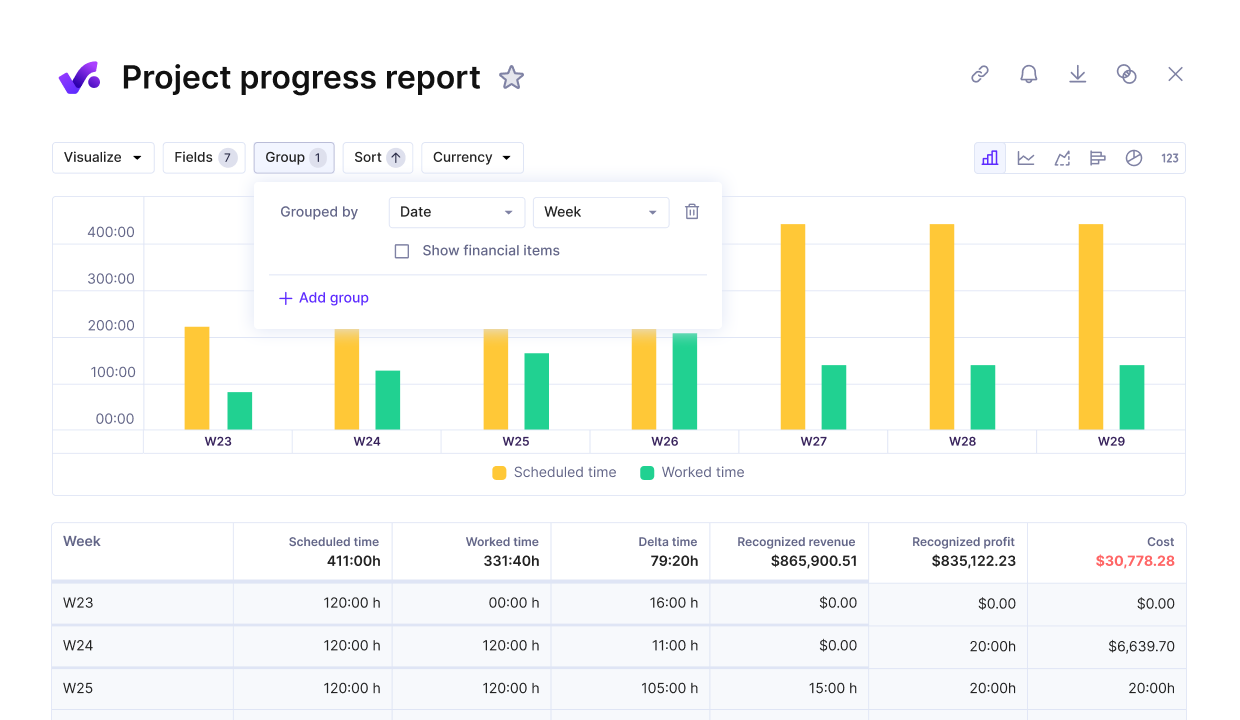
Get real-time project progress reports in Productive.
What Are the Best Practices for Project Implementation?
Best practices for project implementation include setting up consistent workflows, making plans and controls visible to the whole team, and building repeatable habits into project management routines.
When these practices are built into your tools and rhythms, delivery becomes easier to manage and less reactive. There’s a big list of the best project management tools on our blog. You’re welcome.
How To Implement Projects Effectively:
- Standardize templates and workflows across all projects to reduce guesswork and rework.
- Place your implementation plan directly inside your project management tool. Avoid static docs that no one updates.
- Build weekly capacity reviews and client status updates into your delivery rhythm. Treat it like a standing meeting, not an ad-hoc task.
- Keep QA checkpoints, UAT steps, and change approvals visible to both your team and your stakeholders.
- Use reporting dashboards as your single source of truth. Show burn rate, forecast to complete, blockers, and changes in one place.
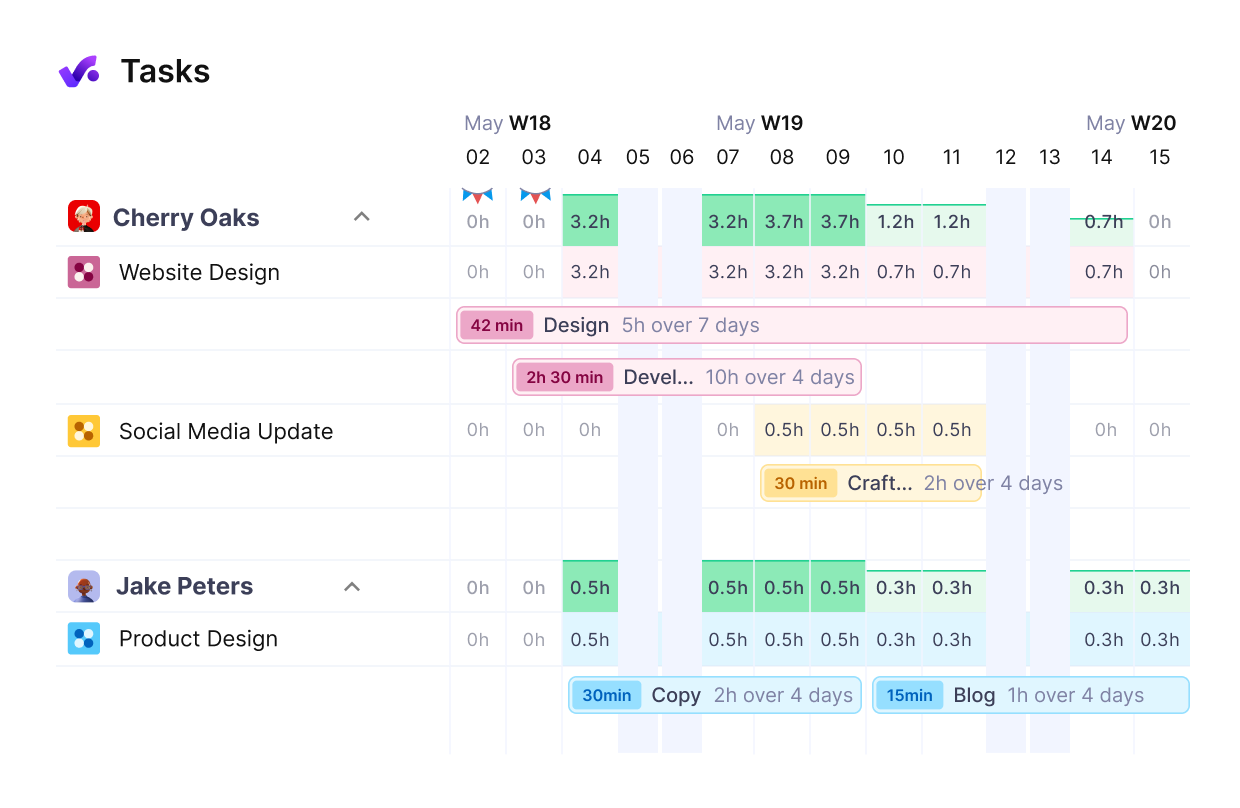
Productive shows you your actual capacity in real-time.
What Tools Should You Use for Project Implementation?
You should manage implementation with an all-in-one project management platform so the plan lives where work actually happens. Static docs get ignored. Siloed tools break context. A connected system makes everything easier to run, track, and report.
Look for a platform that includes:
- Resource management with real-time capacity data
- Project timelines with task dependencies
- Time tracking tied to budgets
- Change request workflows with approvals
- QA checklists and acceptance criteria
- Live dashboards for tracking progress and performance
- Project templates for repeatable work
- Tool integrations and automation options
- Client-facing permissions and visibility settings
If your project manager is chasing updates across spreadsheets, chat threads, and slide decks, the implementation process becomes harder to control. A centralized tool helps your team stay structured, your stakeholders aligned, and your resources managed more effectively.
In case you need extra advice here, head over to our guide on choosing your PM software.
Final Thoughts
A project implementation plan works best when it stays active, visible, and tied to the actual work. Success comes from managing it as a living part of your delivery system, not as a static document created at kickoff.
Teams that track progress, handle changes with structure, and review status regularly are more likely to stay on schedule and meet expectations.
If you want a single place to manage resource planning, change requests, and reporting, book a short 30-minute demo with Productive.
Run Implementation Where Work Happens with Productive
Put your plan, tasks, approvals, and reports in one place. Productive helps you manage capacity, dependencies, and time against budget without extra spreadsheets.
